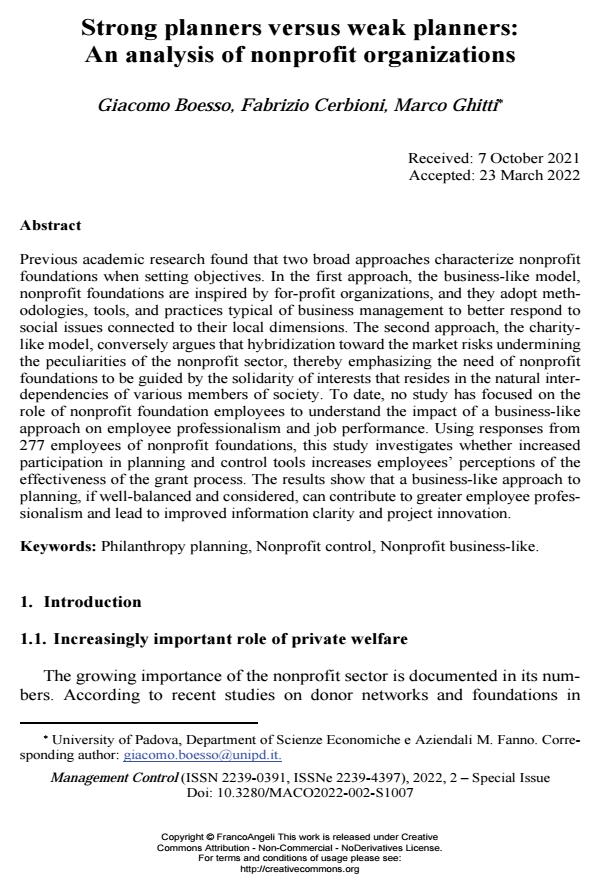Strong planners versus weak planners: An analysis of nonprofit organizations
Titolo Rivista MANAGEMENT CONTROL
Autori/Curatori Giacomo Boesso, Fabrizio Cerbioni, Marco Ghitti
Anno di pubblicazione 2022 Fascicolo 2022/2 Suppl.
Lingua Inglese Numero pagine 24 P. 143-166 Dimensione file 341 KB
DOI 10.3280/MACO2022-002-S1007
Il DOI è il codice a barre della proprietà intellettuale: per saperne di più
clicca qui

FrancoAngeli è membro della Publishers International Linking Association, Inc (PILA)associazione indipendente e non profit per facilitare (attraverso i servizi tecnologici implementati da CrossRef.org) l’accesso degli studiosi ai contenuti digitali nelle pubblicazioni professionali e scientifiche
Previous academic research found that two broad approaches characterize non-profit foundations when setting objectives. In the first approach, the business-like model, nonprofit foundations are inspired by for-profit organizations, and they adopt methodologies, tools, and practices typical of business management to better respond to social issues connected to their local dimensions. The second approach, the charity-like model, conversely argues that hybridization toward the market risks undermining the peculiarities of the nonprofit sector, thereby emphasizing the need of nonprofit foundations to be guided by the solidarity of interests that resides in the natural interdependencies of various members of society. To date, no study has fo-cused on the role of nonprofit foundation employees to understand the impact of a business-like approach on employee professionalism and job performance. Using responses from 277 employees of nonprofit foundations, this study investigates whether increased participation in planning and control tools increases employees’ perceptions of the effectiveness of the grant process. The results show that a busi-ness-like approach to planning, if well-balanced and considered, can contribute to greater employee professionalism and lead to improved information clarity and project innovation.
Parole chiave:Philanthropy planning, Nonprofit control, Nonprofit business-like.
- Capacity building nelle organizzazioni nonprofit: come le fondazioni d'erogazione rinforzano i propri beneficiari Andrea Bafundi, Giacomo Boesso, Fabrizio Cerbioni, in MANAGEMENT CONTROL 2/2025 pp.39
DOI: 10.3280/MACO2025-002003
Giacomo Boesso, Fabrizio Cerbioni, Marco Ghitti, Strong planners versus weak planners: An analysis of nonprofit organizations in "MANAGEMENT CONTROL" 2 Suppl./2022, pp 143-166, DOI: 10.3280/MACO2022-002-S1007